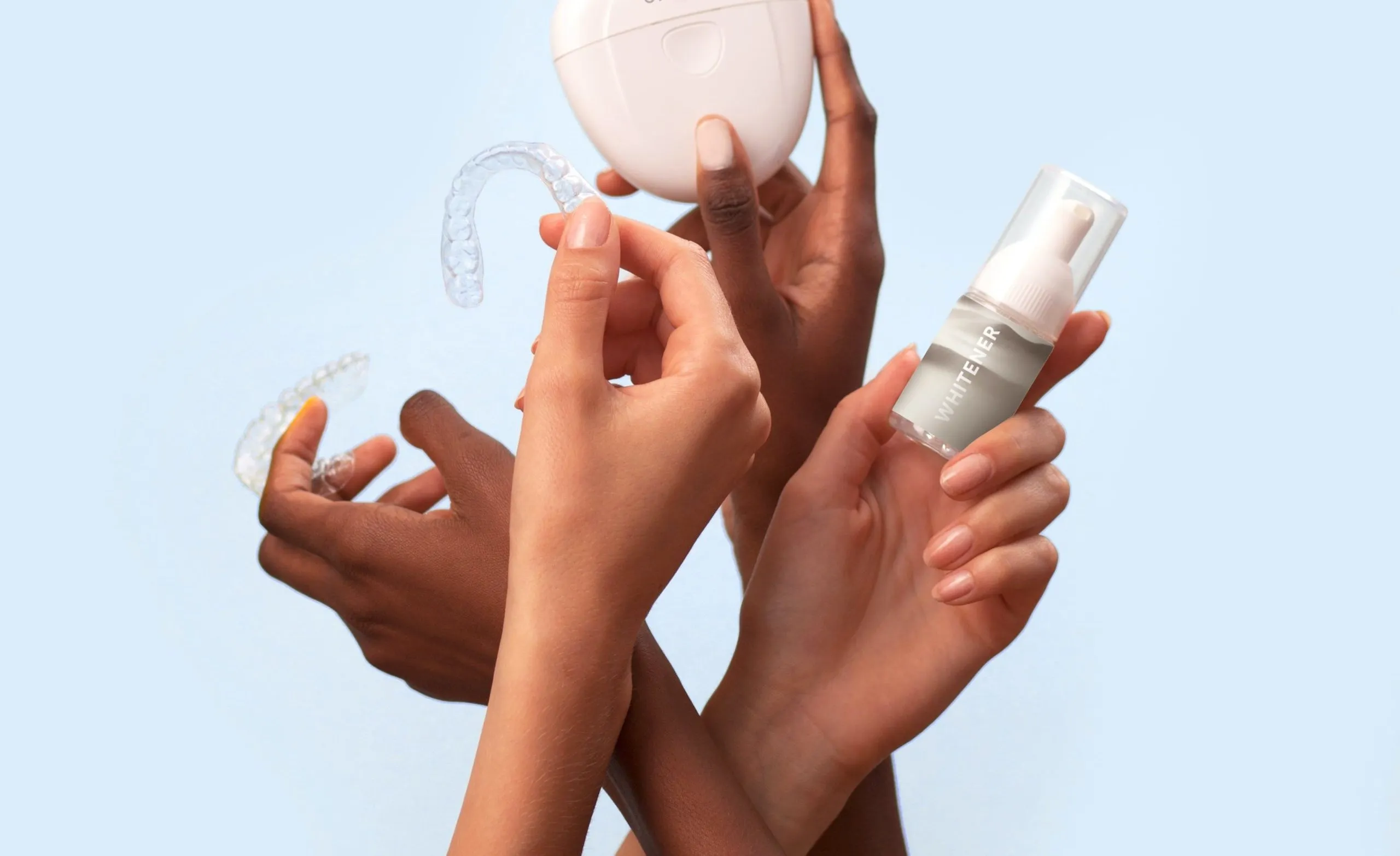What Are Whitening Strips
Whitening strips have become a popular way to enhance the brightness of your smile. They are thin, flexible strips coated with a peroxide-based whitening agent, typically hydrogen peroxide or carbamide peroxide. These strips are designed to adhere to the surface of your teeth, allowing the whitening agent to come into contact with the enamel. The convenience and affordability of these strips have made them a go-to choice for many seeking a quick and easy teeth-whitening solution. They are readily available over-the-counter, eliminating the need for a dental visit for initial treatment. Proper use involves applying the strips to your teeth for a specific duration, as instructed by the product’s guidelines. The active ingredients work to break down the stains and discolorations, resulting in a visibly whiter appearance. However, understanding what whitening strips are is just the first step, the next crucial step is to understand how they work and any potential side effects.
How Whitening Strips Work
The core mechanism of whitening strips involves the oxidation of stain molecules on the tooth surface. The active ingredient, usually hydrogen peroxide or carbamide peroxide, penetrates the enamel and breaks down the organic molecules responsible for discoloration. As these molecules are broken apart, they become less concentrated and the teeth appear whiter. The process doesn’t remove the enamel itself; instead, it targets the stains within the enamel. The effectiveness depends on the concentration of the whitening agent, the duration of application, and the type of stains. Surface stains, caused by things like coffee, tea, and tobacco, are usually easier to remove than deeper, intrinsic stains. Results can vary from person to person, and multiple applications are often needed to achieve the desired level of whiteness. To achieve optimal results and to minimize potential risks, it’s important to follow the manufacturer’s instructions carefully.
Whitening Strips Active Ingredients

The key active ingredients in whitening strips are primarily hydrogen peroxide and carbamide peroxide. Hydrogen peroxide is a strong oxidizing agent, directly breaking down stain molecules, offering quicker results. Carbamide peroxide, on the other hand, breaks down into hydrogen peroxide and urea, providing a slower, more sustained release of the whitening agent. The concentration of these ingredients varies among different products. Higher concentrations often lead to faster results, but also increase the potential for side effects. The percentage of hydrogen peroxide in whitening strips can range from around 6% to as high as 14% or more in professional treatments. Carbamide peroxide is typically used at concentrations ranging from 10% to 22%. Understanding the concentration is vital because it directly influences both the effectiveness and the potential for adverse effects. Always check the product label to ensure it suits your sensitivity level and desired whitening outcome.
Potential Side Effects of Whitening Strips
While whitening strips can be effective, they can also cause side effects. The most common ones include tooth sensitivity and gum irritation. The intensity of these effects can vary based on the concentration of the active ingredient and individual sensitivity levels. It is critical to be aware of these potential problems before starting any whitening treatment. In some cases, the side effects are mild and temporary, while in others, they might require professional care. Moreover, ignoring warning signs can worsen the condition and possibly lead to more serious dental issues. So, when using whitening strips, it is wise to start slowly, follow directions closely, and be ready to consult a dentist if you encounter any concerns. Remember that everyone’s reaction to whitening strips is different; what works for one person might not be ideal for another.
Tooth Sensitivity
Tooth sensitivity is a frequently reported side effect of whitening strips. This occurs because the peroxide in the strips can penetrate the enamel and reach the dentin, which contains nerve endings. This can result in a sharp, temporary pain when consuming hot or cold foods and beverages. The level of sensitivity varies greatly from person to person, some might experience it only slightly, while others could suffer severe discomfort. The sensitivity usually diminishes a few days after finishing the whitening treatment, but it can persist. To manage tooth sensitivity while using whitening strips, consider using a toothpaste designed for sensitive teeth. You can also take breaks between treatments or reduce the duration of application. Consulting your dentist is also a good option for assessing the severity of sensitivity and receiving personalized advice.
Gum Irritation

Another common side effect of whitening strips is gum irritation. This can manifest as redness, swelling, and soreness of the gums. The peroxide in the whitening strips can come into contact with gum tissue and cause inflammation. This irritation is more likely if the strips are not applied correctly, if they overlap the gums, or if you are allergic to the ingredients. The severity of gum irritation typically varies; in most instances, the symptoms are mild and subside shortly after treatment. To mitigate gum irritation, make sure the strips are correctly placed, avoiding contact with the gums. Rinse your mouth thoroughly after removing the strips to remove any residue. If the irritation persists or worsens, stop using the strips and consult your dentist. Your dentist can examine the gums, provide advice, and, if necessary, prescribe anti-inflammatory treatments.
Enamel Damage
Enamel damage, while less common, is a more serious potential risk of using whitening strips. Overuse or misuse of products containing high concentrations of peroxide can weaken the enamel, making teeth more susceptible to decay. Excessive whitening can also lead to the loss of minerals from the enamel, resulting in demineralization. This can manifest as increased tooth sensitivity and an increased risk of cavities. To minimize the risk of enamel damage, always follow the manufacturer’s instructions carefully and avoid exceeding the recommended treatment duration. If you notice any changes in your teeth, such as increased sensitivity, or if you have pre-existing dental issues, consult your dentist. Your dentist can evaluate the condition of your enamel and recommend alternatives to whitening strips or suggest a safe treatment plan.
Other Potential Risks
Besides the common side effects, there are other potential risks associated with whitening strips. Allergic reactions to ingredients like peroxide or other chemicals can cause various symptoms, including skin rash or swelling. If you have any known allergies, it is essential to check the ingredient list carefully before use. Furthermore, whitening strips might not be suitable for everyone, especially those with certain dental conditions. People with cavities, gum disease, or severely worn enamel should consult their dentist before using whitening strips. For individuals with dental work, such as fillings or crowns, whitening strips do not whiten these materials, which can result in uneven coloring. In some cases, excessive use of whitening strips can cause changes in tooth structure and texture, highlighting the importance of responsible usage.
Are Whitening Strips Bad for Everyone

The suitability of whitening strips varies from person to person. While many individuals can safely use these products, they are not suitable for everyone. Certain groups of people should exercise caution or avoid using whitening strips altogether. This includes pregnant or breastfeeding women, as the effects of peroxide on a developing fetus or nursing infant are not fully understood. People with sensitive teeth or gums are more susceptible to side effects and should carefully consider the use of whitening strips. Individuals with cavities, gum disease, or other dental issues should seek treatment from a dentist before starting any whitening treatment. Also, children and teenagers are generally advised to avoid whitening strips as their teeth are still developing. It is always best to consult with a dentist to evaluate your oral health and determine if whitening strips are a safe and appropriate option.
Factors to Consider
When deciding whether to use whitening strips, several factors should be considered. The condition of your oral health is crucial. Ensure that you do not have active dental problems like cavities or gum disease. The concentration of the whitening agent in the strips is also important; stronger concentrations often lead to faster results but can increase side effects. The duration of use and frequency of treatments must be followed to avoid any potential risks. The type of stains you want to address will influence the effectiveness of the strips. Surface stains usually respond better than deep intrinsic stains. It is important to have realistic expectations about the outcome of the whitening. Discussing your goals and any concerns with your dentist will help you make an informed choice and choose the most appropriate whitening strategy for your needs.
Alternatives to Whitening Strips
Several alternatives to whitening strips are available, offering various approaches to teeth whitening. Professional teeth whitening, performed by a dentist, offers the most controlled and often the most effective results. This involves using high-concentration peroxide gels activated by special lights or lasers. The results are usually noticeable after a single session, but this treatment tends to be more expensive. Another option is at-home whitening kits prescribed by a dentist, which involve custom-fitted trays and a lower concentration of peroxide gel. These kits provide more personalized treatment compared to over-the-counter products. Whitening toothpastes, containing mild abrasives or chemicals, can help remove surface stains and improve brightness, though they are less effective on deeper stains. Over-the-counter whitening gels applied with a tray are available too, offering a middle ground between strips and professional treatments. The best option depends on your budget, the severity of staining, and your personal preferences.
Professional Teeth Whitening

Professional teeth whitening provides the most effective and controlled teeth-whitening results. Dentists use high-concentration peroxide gels activated by specialized lights or lasers. These treatments typically provide noticeable whitening after a single session, offering significant improvements in a short time. Dentists can also address specific issues, such as underlying dental problems, before the procedure, ensuring the patient’s safety and optimal outcome. The process usually starts with an evaluation of your oral health to check for cavities or gum disease. Then, a protective barrier is applied to the gums to protect them from the whitening agent. The whitening gel is applied to the teeth and activated by a light or laser. The entire procedure usually takes around an hour, and the results can last for several years with proper maintenance. Although professional whitening is more expensive than at-home options, it often delivers the most impressive and long-lasting results.
At-Home Whitening Options
At-home whitening options offer a more budget-friendly alternative to professional treatments. These options can range from dentist-prescribed kits to over-the-counter products. Dentist-prescribed kits typically include custom-fitted trays and a lower concentration of peroxide gel. This allows for a more personalized treatment plan and better results than over-the-counter products. Over-the-counter options, such as whitening gels and trays, are readily available, but their effectiveness and safety can vary. Whitening toothpastes and mouthwashes can also help to remove surface stains and maintain whiteness, but they are less effective on deeper discoloration. When using at-home treatments, it is essential to follow the instructions carefully to avoid potential side effects and ensure effective results. Regular dental checkups and professional cleanings are still recommended for optimal oral health, regardless of the whitening method you choose.
Conclusion
Whitening strips can be an effective and convenient way to brighten your smile, but they do come with potential risks. While some users experience no significant side effects, others may encounter tooth sensitivity or gum irritation. Careful consideration of your oral health, the product’s ingredients, and the application instructions is essential. Consulting a dentist is crucial, especially if you have pre-existing dental conditions or are unsure if whitening strips are right for you. By weighing the pros and cons and understanding the potential side effects, you can make an informed decision about whether to use whitening strips and take steps to minimize any risks. Remember that maintaining good oral hygiene, including regular brushing, flossing, and professional cleanings, is vital for a healthy and radiant smile, regardless of your chosen whitening method.
